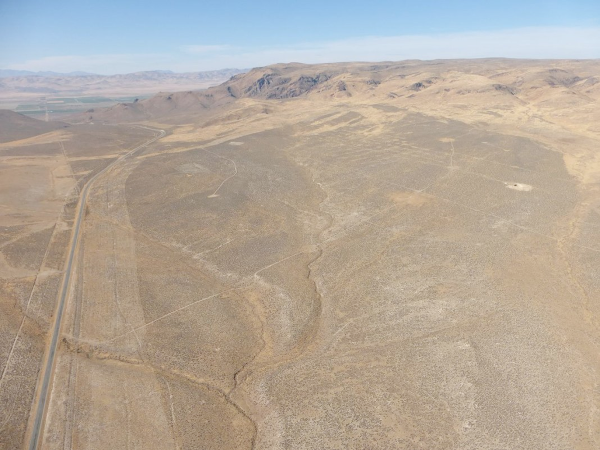
Aerial view of Thacker Pass, looking west with the Pine Forest Range rising in the distance.
By David von Seggern, past-Chair, Toiyabe Chapter
By now nearly every Toiyabe Chapter member has heard of the proposed Thacker Pass lithium mine in north-central Nevada. There is only one current lithium mine in the US: a large-scale evaporation mine site in Clayton Valley, Nevada. That operation has gone on since the 1970s at a relatively low level with little media visibility. But lithium mining in Nevada broke onto national news in late 2020 with the Thacker Pass proposed mine in north-central Nevada. The draft Environmental Impact Statement was issued in summer of 2020, and the Toiyabe Chapter submitted comments in September. We did not take a pro or con position on the mine, meaning we were essentially neutral.
The EIS was finalized in December and a Record of Decision (ROD) was released in January 2021, giving the green light to this mine. With an impending wave of lithium mining prospects, I thought it was prudent to request that national Sierra Club organize a task force to examine what impacts this new mineral mining might have. With that in mind, the national Sierra Club conservation office agreed with our position. Thacker Pass was likely a tip of the iceberg. The issue was acute because Sierra Club strongly promotes the energy transition, with transportation infrastructure near the top of the list for changes that need to be made to reduce greenhouse gas (GHG) emissions. At the same time, we stand for holding mines accountable to stringent environmental standards, and we respect the rights and perspectives of local communities, especially Indigenous Americans.
I published an article on lithium mining in the March 2021 edition of Desert Report, updated in June 2021. Everyone interested in knowing the background on domestic lithium mining should read the article and the update. One should know that Nevada has a high potential for lithium mining.
Since the ROD was issued, several NPOs in Nevada and a rancher in the vicinity of Thacker Pass have filed suite against the BLM on grounds that the EIS is flawed. We were asked to join the suit of the former but declined. My reasoning is that we needed to take a deeper look at lithium mining and produce some guidance for examining later lithium mining proposals. It is not inconceivable that Toiyabe Chapter will take a belated stance on the Thacker Pass mine on the basis of the task force document.
On June 8, 2021, the BLM and Thacker Pass mine owners reached an agreement to halt all disturbance at the site until July 29, 2021, effectively an injunction on the development until the merits of the law suits are decided.
Nearly every agency, analyst, and scientist believes that lithium batteries are the primary tool at the moment in the transition of the transportation industry. Other technologies may eventually supplant lithium-ion batteries, but for the moment they are the promise to electrify our transportation. Against this backdrop, greatly increased mining of lithium is essential. How does the club weigh the impact of a new and growing mining industry against the need to reduce GHG emissions? The task force was formed to pull together essential information and make recommendations that would help to address this dilemma.
The task force started in April; we intend to finish in July. Lithium mining is an extraction industry with new and rapid technological developments. We already recognize that we won’t have definitive recommendations that can persist due to these ongoing developments. Our hope is that highly disruptive mining methods such as proposed at Thacker Pass and such as already exist at Clayton Valley today will be supplanted by more benign methods.